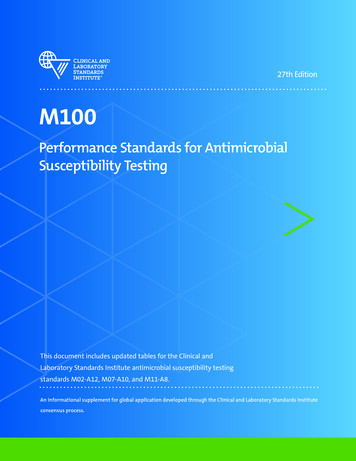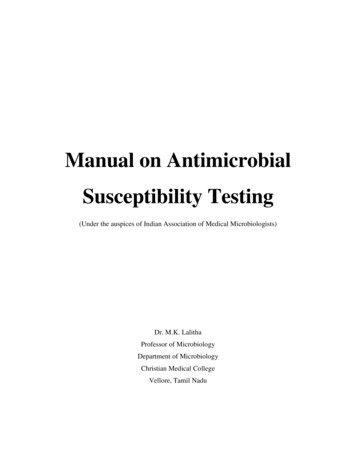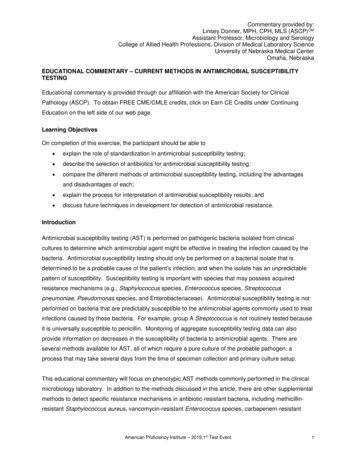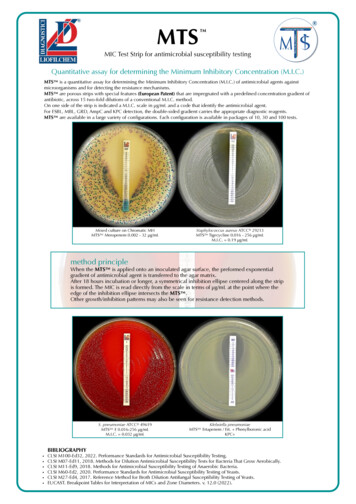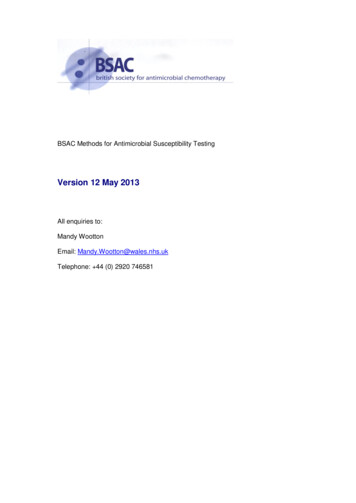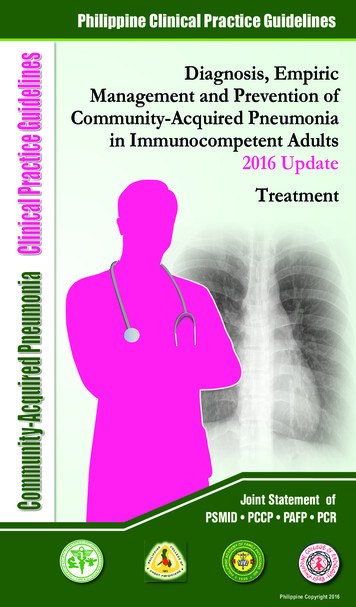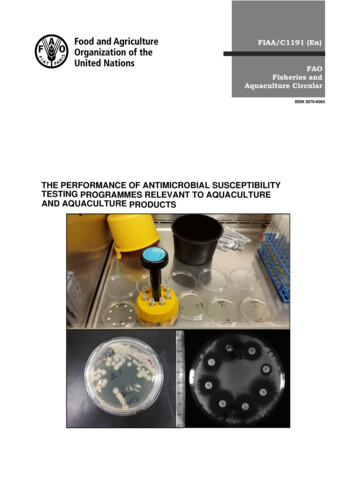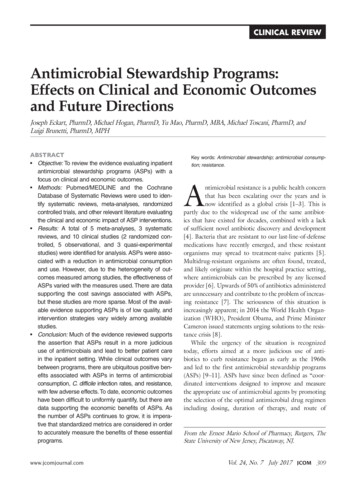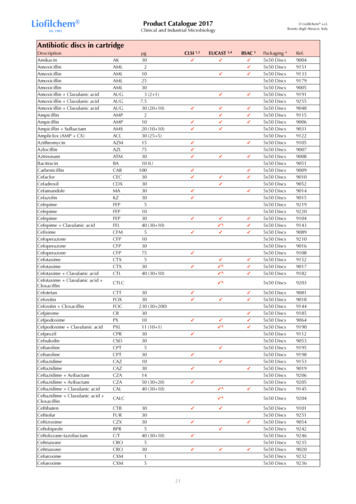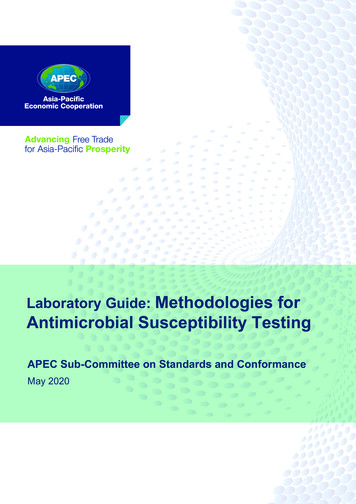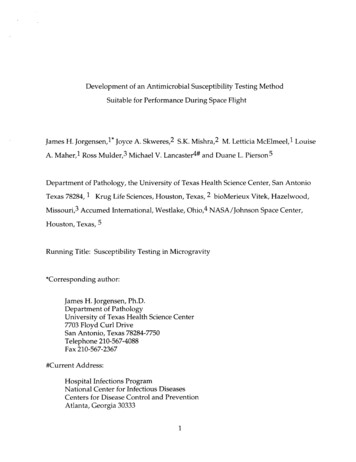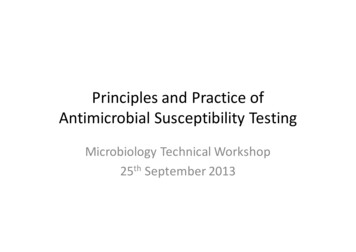
Transcription
Principles and Practice ofAntimicrobial Susceptibility TestingMicrobiology Technical Workshop25th September 2013
Scope History Why Perform Antimicrobial Susceptibility Testing? How to Perform an Antimicrobial Susceptibility Test–––– IsolateMethod (phenotypic, special tests, genotypic)DrugStandards (how breakpoints are derived; CLSI, EUCAST, BSAC, CDS)Understanding An Antimicrobial Susceptibility Test– Categorical interpretation– 90-60 rule Summary
History
Source: http://www.s1darvel.com/Source: http://www.biography.com/Sir Alexander Fleming(1881-1955)
“When I woke up just after dawn onSeptember 28, 1928, I certainly didn't planto revolutionize all medicine by discoveringthe world's first antibiotic, or bacteria killer.But I suppose that was exactly what I did.”
Why Perform AntimicrobialSusceptibility Testing?
EmpiricTherapyInvestigationsDefinitiveTherapy
Patient LAM 89 year old Chinese female Previously hospitalized 2 months ago for cystitis– Urine culture – ESBL positive E. coli– Blood cultures – negative Now admitted from the A&E with fever, dysuria andincreased urinary frequency for 3 days– Urine microscopy – RBC 3, WBC 2000, EC 0– Urine culture – no bacterial growth Started empirically on IV Piperacillin/tazobactam
Predict treatment outcome Guide selection of most appropriate agent Provide alternatives – drug allergy, oral option
How to Perform an AntimicrobialSusceptibility Test
IsolateDrugMethodStandardsResults
Isolate Identity of bacterial isolate Normal flora Clinically significant number of colonies Predictable antibiotic susceptibility profile
Method Phenotypic– Zone diameter– Minimum inhibitory concentration (MIC) Special tests GenotypicSource: CLSI M100-S23E Performance Standards for Antimicrobial Susceptibility Testing - 23rd Informational Supplement
Source: http://www.cdc.gov/Source: http://www.cdc.gov/Disk Diffusion
Source: http://bacterioweb.univ-fcomte.fr/Etest (Epsilometer test)
Source: http://www.cdc.gov/
Source: http://web.carteret.edu/Source: http://web.carteret.edu/Broth Macrodilution
Source: www.biomerieux.comSource: www.biomerieux.comAutomated (Vitek2)Source: www.biomerieux.com
Source: http://microblog.me.uk/D-Test for inducible clindamycin resistance
CephalosporinClavulanic acidCephalosporinESBL Detection (double-disk approximation)
Source: http://www.cepheid.com/Source: http://www.pih.org/Source: http://www.ahsoman.com/Source: http://www.pih.org/
Drug Species to be tested Institution formulary Commonly used antimicrobials Availability of antimicrobial agent for testing Tailored to specific needs of institution––––Infectious disease physiciansClinical microbiologistsPharmacistsCommittees concerned with institutional formulary
Source: http://www.eucast.org/
Standards MIC distribution– Wild-type– Epidemiological cut-off (ECOFF) Pharmacokinetic Pharmacodynamic Clinical data
susceptibleresistant807060504030201000.125 0.250.51248163264increasing concentration of antibiotic128256
susceptibleresistant807060504030201000.125 0.250.51248163264increasing concentration of antibiotic128256
Source: http://mic.eucast.org/
Source: http://mic.eucast.org/
?Source: http://mic.eucast.org/
StandardLocationMediaInoculumCLSIAmerica, severalareas of Europe,Asia, AustraliaMueller-Hinton agarMueller-Hinton agar with 5% sheep blood0.5 McFarlandEUCASTEuropeMueller-Hinton agarMueller-Hinton agar with 5% defibrinated horseblood 20 mg/L β-NAD0.5 McFarlandBSACUnited KingdomIso-Sensitest agarIso-Sensitest agar with 5% defibrinated horseblood 20 mg/L NAD0.5 McFarlandthen dilute(refer to Table)CDSAustraliaSensitest agarSensitest agar with 5% horse bloodRefer to Figure
Source: http://bsac.org.uk/ (Version 12 May 2013)
Source: http://bsac.org.uk/ (Version 12 May 2013)
Source: http://bsac.org.uk/ (Version 12 May 2013)
Source: http://web.med.unsw.edu.au/ (Sixth Edition)
Source: http://web.med.unsw.edu.au/ (Sixth Edition)
CLSISource: CLSI M100-S23E Performance Standards for Antimicrobial Susceptibility Testing - 23rd Informational Supplement
Source: CLSI M100-S23E Performance Standards for Antimicrobial Susceptibility Testing - 23rd Informational Supplement
EUCASTSource: http://www.eucast.org/
Source: http://www.eucast.org/
BSACSource: http://bsac.org.uk/ (Version 12 May 2013)
CDSSource: http://web.med.unsw.edu.au/ (Sixth Edition)
Source: http://web.med.unsw.edu.au/ (Sixth Edition)
Source: http://web.med.unsw.edu.au/ (Sixth Edition)Source: http://web.med.unsw.edu.au/ (Sixth Edition)
Understanding An AntimicrobialSusceptibility Test
IdentifyTestReport
Categorical InterpretationCategoryInterpretationSusceptible High likelihood of therapeutic successResistant High likelihood of therapeutic failureIntermediate Uncertain therapeutic effectDrug concentration at body sitesBuffer zoneSusceptible-dose dependent (S-DD) Antifungal susceptibility testingSusceptibility dependent on achievingmaximal possible blood levelNonsusceptible Often seen with new antimicrobialagents
Source: Rex and Pfaller CID 2002 - Has Antifungal Susceptibility Testing Come of Age?
Summary Antimicrobial susceptibility tests allows us to– Predict treatment outcome– Guide selection of most appropriate agent– Provide alternatives Factors to consider––––IsolateMethodDrugStandards Understanding the results– Categorical interpretation– 90-60 rule
Source: http://www.channelnewsasia.com/Thank you for your attention!Dr Jamie Tan (jamie.tan.b.x@sgh.com.sg)RegistrarDepartment of PathologySingapore General Hospital
Why Perform Antimicrobial Susceptibility Testing? How to Perform an Antimicrobial Susceptibility Test – Isolate – Method (phenotypic, special tests, genotypic) – Drug – Standards (how breakpoints are derived; CLSI, EUCAST, BSAC, CDS) Understanding An Antimicrobial Susceptibilit
